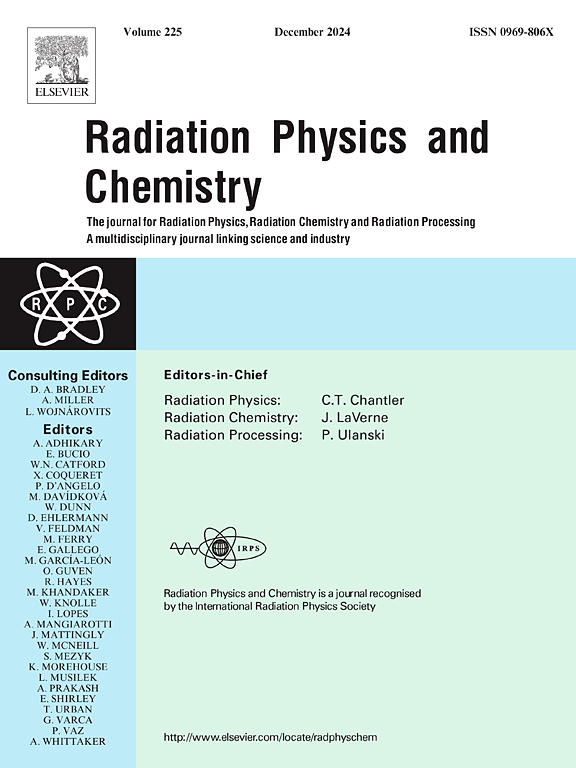Investigation of mechanical and radiation shielding properties of Sm–Sm2O3 reinforced Al–B4C composite
IF 2.8
3区 物理与天体物理
Q3 CHEMISTRY, PHYSICAL
引用次数: 0
Abstract
In this study, Al–20%B4C-x%(Sm, Sm2O3) (x = 1, 3, and 5) composites were prepared using mechanical alloying to investigate their neutron shielding and mechanical properties. After pelletizing and sintering the prepared powder composites, their microstructures were characterized using X-ray diffraction, energy-dispersive X-ray spectroscopy, and scanning electron microscopy. Hardness, density, and corrosion tests were performed on the composites. Thermal and fast neutron shielding properties were calculated using the MCNP simulation code. Experimental measurements of neutron shielding were carried out using an Am–Be neutron source. Experimental results showed that 5% Sm-reinforced composites exhibited better neutron shielding than Sm2O3-reinforced composites at all doping ratios. Simulation calculations indicated that the highest thermal neutron shielding rate was observed in Sm-reinforced composites, while the highest fast neutron shielding rate was observed in 5% Sm2O3-reinforced composites. This research provides important data for researchers interested in developing thermal and fast neutron shielding materials.
研究 Sm-Sm2O3 增强 Al-B4C 复合材料的机械和辐射屏蔽性能
本研究采用机械合金化方法制备了 Al-20%B4C-x%(Sm,Sm2O3)(x = 1、3 和 5)复合材料,以研究其中子屏蔽和机械性能。在对制备的粉末复合材料进行造粒和烧结后,使用 X 射线衍射、能量色散 X 射线光谱和扫描电子显微镜对其微观结构进行了表征。对复合材料进行了硬度、密度和腐蚀测试。使用 MCNP 模拟代码计算了热屏蔽和快中子屏蔽特性。使用 Am-Be 中子源进行了中子屏蔽实验测量。实验结果表明,在所有掺杂比率下,5% Sm 增强复合材料的中子屏蔽性能都优于 Sm2O3 增强复合材料。模拟计算表明,Sm 增强复合材料的热中子屏蔽率最高,而 5% Sm2O3 增强复合材料的快中子屏蔽率最高。这项研究为有意开发热中子和快中子屏蔽材料的研究人员提供了重要数据。
本文章由计算机程序翻译,如有差异,请以英文原文为准。
求助全文
约1分钟内获得全文
求助全文
来源期刊

Radiation Physics and Chemistry
化学-核科学技术
CiteScore
5.60
自引率
17.20%
发文量
574
审稿时长
12 weeks
期刊介绍:
Radiation Physics and Chemistry is a multidisciplinary journal that provides a medium for publication of substantial and original papers, reviews, and short communications which focus on research and developments involving ionizing radiation in radiation physics, radiation chemistry and radiation processing.
The journal aims to publish papers with significance to an international audience, containing substantial novelty and scientific impact. The Editors reserve the rights to reject, with or without external review, papers that do not meet these criteria. This could include papers that are very similar to previous publications, only with changed target substrates, employed materials, analyzed sites and experimental methods, report results without presenting new insights and/or hypothesis testing, or do not focus on the radiation effects.
 求助内容:
求助内容: 应助结果提醒方式:
应助结果提醒方式:


